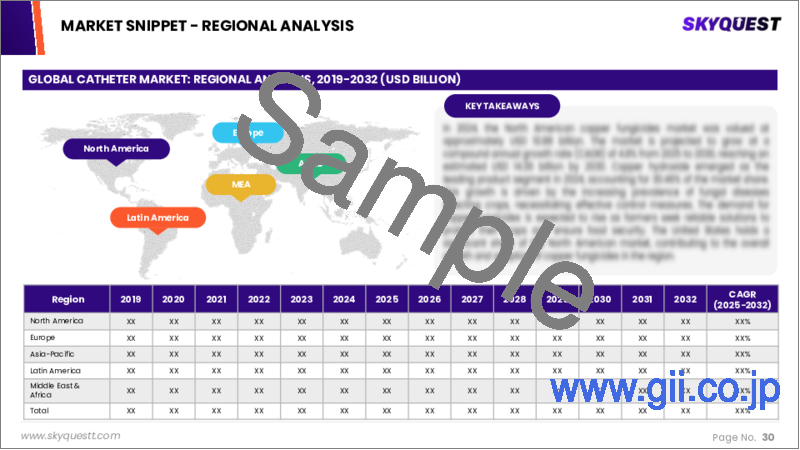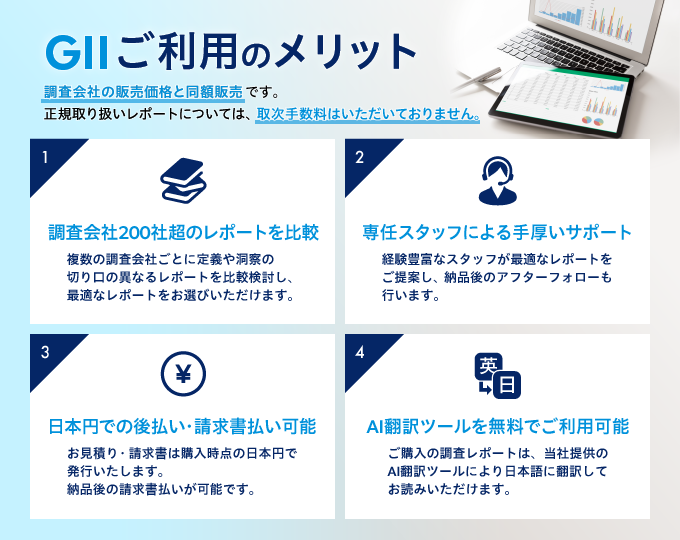|
|
市場調査レポート
商品コード
1624120
カテーテルの市場規模、シェア、成長分析、製品別、最終用途別、地域別 - 産業予測、2025~2032年Catheter Market Size, Share, Growth Analysis, By Product (Cardiovascular Catheters, Urology Catheters), By End Use (Hospital Stores, Retail Stores), By Region - Industry Forecast 2025-2032 |
||||||
|
|||||||
| カテーテルの市場規模、シェア、成長分析、製品別、最終用途別、地域別 - 産業予測、2025~2032年 |
|
出版日: 2025年01月01日
発行: SkyQuest
ページ情報: 英文 157 Pages
納期: 3~5営業日
|
全表示
- 概要
- 目次
カテーテルの世界市場規模は2023年に268億米ドルと評価され、2024年の290億5,000万米ドルから2032年には553億9,000万米ドルに成長し、予測期間(2025-2032年)のCAGRは8.4%で成長する見通しです。
世界のカテーテル市場は、高齢化とともに心血管疾患や腎臓疾患などの慢性疾患の有病率が上昇していることを背景に、力強い成長を遂げています。カテーテルに対する需要の増加は、長期的な医療管理、特に患者の快適性を高め回復時間を短縮する低侵襲手術や外来手術において、カテーテルが不可欠な役割を果たすことに起因しています。センサーやワイヤレス技術を搭載したロボット支援カテーテルやスマートカテーテルなどの革新的な進歩により、診断能力や治療能力が向上しています。しかし、同市場は課題に直面しており、特にカテーテル関連感染や厳しい規制基準が、新規参入企業の市場参入を複雑にしています。さらに、コスト面の懸念や特定の地域での償還制限も、特に新興市場における成長を阻害する可能性があり、品質と安全基準を遵守した手頃な価格のソリューションの必要性が浮き彫りになっています。
目次
イントロダクション
- 調査の目的
- 調査範囲
- 定義
調査手法
- 情報調達
- 二次データと一次データの方法
- 市場規模予測
- 市場の前提条件と制限
エグゼクティブサマリー
- 世界市場の見通し
- 供給と需要の動向分析
- セグメント別機会分析
市場力学と見通し
- 市場概要
- 市場規模
- 市場力学
- 促進要因と機会
- 抑制要因と課題
- ポーターの分析
主な市場の考察
- 重要成功要因
- 競合の程度
- 主な投資機会
- 市場エコシステム
- 市場の魅力指数(2024年)
- PESTEL分析
- マクロ経済指標
- バリューチェーン分析
- 価格分析
- 規制分析
- 特許分析
カテーテル市場規模:製品別
- 市場概要
- 心臓血管カテーテル
- 電気生理学カテーテル
- PTCAバルーンカテーテル
- IVUSカテーテル
- PTAバルーンカテーテル
- 泌尿器科カテーテル
- 血液透析カテーテル
- 腹膜カテーテル
- フォーリーカテーテル
- 間欠カテーテル
- 外部カテーテル
- 静脈カテーテル
- 末梢カテーテル
- 正中線末梢カテーテル
- 中心静脈カテーテル
- 神経血管カテーテル
- 特殊カテーテル
- 創傷/外科用カテーテル
- オキシメトリーカテーテル
- 熱希釈カテーテル
- IUIカテーテル
カテーテル市場規模:最終用途別
- 市場概要
- 病院売店
- 小売店
- その他
カテーテル市場規模
- 北米
- 米国
- カナダ
- 欧州
- ドイツ
- スペイン
- フランス
- 英国
- イタリア
- その他欧州地域
- アジア太平洋地域
- 中国
- インド
- 日本
- 韓国
- その他アジア太平洋地域
- ラテンアメリカ
- ブラジル
- その他ラテンアメリカ地域
- 中東・アフリカ
- GCC諸国
- 南アフリカ
- その他中東・アフリカ
競合情報
- 上位5社の比較
- 主要企業の市場ポジショニング(2024年)
- 主な市場企業が採用した戦略
- 市場の最近の動向
- 企業の市場シェア分析(2024年)
- 主要企業の企業プロファイル
- 会社概要
- 製品ポートフォリオ分析
- セグメント別シェア分析
- 収益の前年比比較(2022-2024)
主要企業プロファイル
- Medtronic plc(Ireland)
- Teleflex Incorporated(USA)
- Abbott Laboratories(USA)
- B. Braun Melsungen AG(Germany)
- Edwards Lifesciences Corporation(USA)
- Coloplast A/S(Denmark)
- Johnson & Johnson(USA)
- Terumo Corporation(Japan)
- Becton, Dickinson and Company(BD)(USA)
- Boston Scientific Corporation(USA)
- ConvaTec Group plc(UK)
- Hollister Incorporated(USA)
- Stryker Corporation(USA)
- Cook Medical(USA)
- Merit Medical Systems, Inc.(USA)
- Cure Medical LLC(USA)
- Amsino International, Inc.(USA)
- ASID BONZ GmbH(Germany)
- CompactCath Inc.(USA)
- Go Medical Industries Pty Ltd(Australia)
結論と推奨事項
Global Catheter Market size was valued at USD 26.8 billion in 2023 and is poised to grow from USD 29.05 billion in 2024 to USD 55.39 billion by 2032, growing at a CAGR of 8.4% during the forecast period (2025-2032).
The global catheter market is witnessing robust growth, driven by the rising prevalence of chronic diseases such as cardiovascular and kidney disorders, alongside an ageing population. Increased demand for catheters stems from their essential role in long-term medical management, particularly in minimally invasive and outpatient procedures that enhance patient comfort and reduce recovery times. Innovative advancements, including robotic-assisted and smart catheters equipped with sensors and wireless technology, are enhancing diagnostic and therapeutic capabilities. However, the market faces challenges, notably catheter-associated infections and stringent regulatory standards, which can complicate market entry for new players. Additionally, cost concerns and limited reimbursement in certain regions may impede growth, particularly in emerging markets, highlighting the need for affordable solutions that adhere to quality and safety standards.
Top-down and bottom-up approaches were used to estimate and validate the size of the Global Catheter market and to estimate the size of various other dependent submarkets. The research methodology used to estimate the market size includes the following details: The key players in the market were identified through secondary research, and their market shares in the respective regions were determined through primary and secondary research. This entire procedure includes the study of the annual and financial reports of the top market players and extensive interviews for key insights from industry leaders such as CEOs, VPs, directors, and marketing executives. All percentage shares split, and breakdowns were determined using secondary sources and verified through Primary sources. All possible parameters that affect the markets covered in this research study have been accounted for, viewed in extensive detail, verified through primary research, and analyzed to get the final quantitative and qualitative data.
Global Catheter Market Segmental Analysis
Global Catheter Market is segmented by Product, End Use and region. Based on Product, the market is segmented into Cardiovascular Catheters, Urology Catheters, Intravenous Catheters, Neurovascular Catheters and Specialty Catheters. Based on End Use, the market is segmented into Hospital Stores, Retail Stores and Others. Based on region, the market is segmented into North America, Europe, Asia Pacific, Latin America and Middle East & Africa.
Driver of the Global Catheter Market
The global catheter market is significantly driven by the rising aging population, which increases the demand for these medical devices. As people age, they tend to experience a higher incidence of chronic conditions such as cardiovascular diseases and urinary disorders, both of which frequently necessitate catheterization. The growing number of elderly individuals worldwide underscores the urgent need for effective healthcare solutions, including catheters, to manage their complex medical needs. Consequently, the expanding geriatric demographic plays a critical role in shaping the catheter market, as healthcare providers seek to ensure improved patient outcomes through enhanced catheter technology and usage.
Restraints in the Global Catheter Market
The global catheter market faces significant restraints largely due to rigorous regulatory requirements that manufacturers must navigate. Compliance with high-quality standards necessitates substantial investment in research and development, creating substantial barriers for new entrants looking to join the market. This regulatory landscape not only complicates the operational processes of existing players but also influences market dynamics, potentially slowing innovation and limiting competitive options. The complexities involved in meeting these stringent guidelines can hinder growth and expansion for both established companies and newcomers, ultimately affecting the overall market potential and accessibility within the catheter industry.
Market Trends of the Global Catheter Market
The Global Catheter market is experiencing a significant shift towards home healthcare, propelled by increasing patient preference for comfort and cost-effective solutions. As chronic conditions rise, more patients are opting for catheter use at home, facilitated by advancements in medical technology that ensure safety and efficacy. This trend is spurring demand for user-friendly catheter products that can be easily managed by patients and caregivers alike. Manufacturers are responding by innovating to meet these needs, focusing on designing catheters that are not only effective but also tailored for at-home use, marking a transformative phase in how medical care is delivered.
Table of Contents
Introduction
- Objectives of the Study
- Scope of the Report
- Definitions
Research Methodology
- Information Procurement
- Secondary & Primary Data Methods
- Market Size Estimation
- Market Assumptions & Limitations
Executive Summary
- Global Market Outlook
- Supply & Demand Trend Analysis
- Segmental Opportunity Analysis
Market Dynamics & Outlook
- Market Overview
- Market Size
- Market Dynamics
- Drivers & Opportunities
- Restraints & Challenges
- Porters Analysis
- Competitive rivalry
- Threat of substitute
- Bargaining power of buyers
- Threat of new entrants
- Bargaining power of suppliers
Key Market Insights
- Key Success Factors
- Degree of Competition
- Top Investment Pockets
- Market Ecosystem
- Market Attractiveness Index, 2024
- PESTEL Analysis
- Macro-Economic Indicators
- Value Chain Analysis
- Pricing Analysis
- Regulatory Analysis
- Patent Analysis
Global Catheter Market Size by Product & CAGR (2025-2032)
- Market Overview
- Cardiovascular Catheters
- Electrophysiology Catheters
- PTCA Balloon Catheters
- IVUS Catheters
- PTA Balloon Catheters
- Urology Catheters
- Hemodialysis Catheters
- Peritoneal Catheters
- Foley Catheters
- Intermittent Catheters
- External Catheters
- Intravenous Catheters
- Peripheral Catheters
- Midline Peripheral Catheters
- Central Venous Catheters
- Neurovascular Catheters
- Specialty Catheters
- Wound/Surgical Catheters
- Oximetry Catheters
- Thermodilution Catheters
- IUI Catheters
Global Catheter Market Size by End Use & CAGR (2025-2032)
- Market Overview
- Hospital Stores
- Retail Stores
- Others
Global Catheter Market Size & CAGR (2025-2032)
- North America (Product, End Use)
- US
- Canada
- Europe (Product, End Use)
- Germany
- Spain
- France
- UK
- Italy
- Rest of Europe
- Asia Pacific (Product, End Use)
- China
- India
- Japan
- South Korea
- Rest of Asia-Pacific
- Latin America (Product, End Use)
- Brazil
- Rest of Latin America
- Middle East & Africa (Product, End Use)
- GCC Countries
- South Africa
- Rest of Middle East & Africa
Competitive Intelligence
- Top 5 Player Comparison
- Market Positioning of Key Players, 2024
- Strategies Adopted by Key Market Players
- Recent Developments in the Market
- Company Market Share Analysis, 2024
- Company Profiles of All Key Players
- Company Details
- Product Portfolio Analysis
- Company's Segmental Share Analysis
- Revenue Y-O-Y Comparison (2022-2024)
Key Company Profiles
- Medtronic plc (Ireland)
- Company Overview
- Business Segment Overview
- Financial Updates
- Key Developments
- Teleflex Incorporated (USA)
- Company Overview
- Business Segment Overview
- Financial Updates
- Key Developments
- Abbott Laboratories (USA)
- Company Overview
- Business Segment Overview
- Financial Updates
- Key Developments
- B. Braun Melsungen AG (Germany)
- Company Overview
- Business Segment Overview
- Financial Updates
- Key Developments
- Edwards Lifesciences Corporation (USA)
- Company Overview
- Business Segment Overview
- Financial Updates
- Key Developments
- Coloplast A/S (Denmark)
- Company Overview
- Business Segment Overview
- Financial Updates
- Key Developments
- Johnson & Johnson (USA)
- Company Overview
- Business Segment Overview
- Financial Updates
- Key Developments
- Terumo Corporation (Japan)
- Company Overview
- Business Segment Overview
- Financial Updates
- Key Developments
- Becton, Dickinson and Company (BD) (USA)
- Company Overview
- Business Segment Overview
- Financial Updates
- Key Developments
- Boston Scientific Corporation (USA)
- Company Overview
- Business Segment Overview
- Financial Updates
- Key Developments
- ConvaTec Group plc (UK)
- Company Overview
- Business Segment Overview
- Financial Updates
- Key Developments
- Hollister Incorporated (USA)
- Company Overview
- Business Segment Overview
- Financial Updates
- Key Developments
- Stryker Corporation (USA)
- Company Overview
- Business Segment Overview
- Financial Updates
- Key Developments
- Cook Medical (USA)
- Company Overview
- Business Segment Overview
- Financial Updates
- Key Developments
- Merit Medical Systems, Inc. (USA)
- Company Overview
- Business Segment Overview
- Financial Updates
- Key Developments
- Cure Medical LLC (USA)
- Company Overview
- Business Segment Overview
- Financial Updates
- Key Developments
- Amsino International, Inc. (USA)
- Company Overview
- Business Segment Overview
- Financial Updates
- Key Developments
- ASID BONZ GmbH (Germany)
- Company Overview
- Business Segment Overview
- Financial Updates
- Key Developments
- CompactCath Inc. (USA)
- Company Overview
- Business Segment Overview
- Financial Updates
- Key Developments
- Go Medical Industries Pty Ltd (Australia)
- Company Overview
- Business Segment Overview
- Financial Updates
- Key Developments





